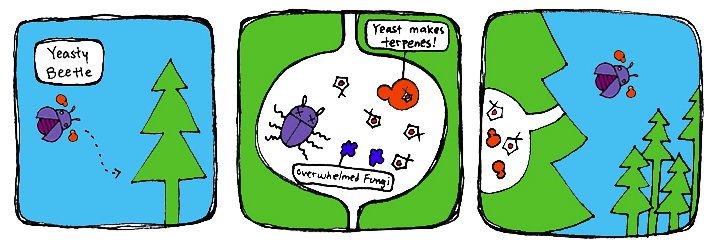Team:British Columbia/Model2
From 2011.igem.org

MODEL 2: Dynamics of Mountain Pine Beetle Populations in British Columbia
Modeling the mountain pine beetle epidemic using a probabilistic clustering approach
The Beetle's Strategy
The mountain pine beetle lives in symbiosis with the blue-stain fungus (which has the ability to break down monoterpenes). Their relationship allows the mountain pine beetle to avoid the toxic effects of the monoterpenes, while the blue-stain fungi is carried inside the tree where it can happily grow and colonize. Monoterpenes produced by trees deter away insect attack, but stressed trees produce low amounts of monoterpenes. Due to this, both the pine beetle and the fungi exploit the tree for their own benefits. The beetles lay their larvaes inside, while the blue-stain fungi grows inside the tree and provide a source of nutrient for the young larvaes. Once the larvaes grow into adult beetles, they carry the blue-stain fungus and infects other trees. The trees die from this because the blue stain fungus blocks transport of water and nutrients. Like an infection, the pine beetle-blue stain fungi spreads throughout the forest, causing mass destruction to the forest health and ecosystems that rely on the trees.
Our Theoretical Strategy: iSynthase Trapbox
To restore the balance of monoterpenes to the trees, we propose to introduce our monoterpene producing yeast into the environment. Like the beetle's strategy, we will introduce our yeast products into trap boxes attracting the beetles by artificial pheromones. Just like the pine beetle infestation, the yeast will be carried to through the pine beetle and into the tree.
We understand that This is a huge leap in connecting from bench top to environment
Simulation
We simulated the expansion of the MPB population from year 2011 to 2020 using the estimates obtained from the clustering analysis.
 "
"

